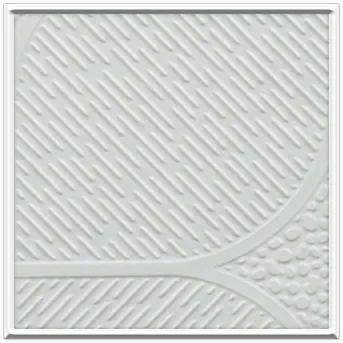- Afrikaans
- Albanian
- Amharic
- Arabic
- Armenian
- Azerbaijani
- Basque
- Belarusian
- Bengali
- Bosnian
- Bulgarian
- Catalan
- Cebuano
- Corsican
- Croatian
- Czech
- Danish
- Dutch
- English
- Esperanto
- Estonian
- French
- German
- Greek
- Hindi
- Indonesian
- irish
- Italian
- Japanese
- Korean
- Lao
- Malay
- Myanmar
- Norwegian
- Norwegian
- Polish
- Portuguese
- Romanian
- Russian
- Serbian
- Spanish
- Swedish
- Thai
- Turkish
- Ukrainian
- Uzbek
- Vietnamese
Dis . 04, 2024 10:38 Back to list
gypsum and grid ceiling
Understanding Gypsum and Grid Ceiling Systems
Gypsum and grid ceilings are an essential part of modern architectural design, offering both aesthetic appeal and functional advantages. These systems are widely utilized in residential, commercial, and industrial buildings, providing a versatile solution for concealing structural elements while enhancing the overall look of interior spaces. In this article, we will delve into the composition, benefits, installation, and various applications of gypsum and grid ceiling systems.
What are Gypsum and Grid Ceilings?
Gypsum ceiling systems are made from gypsum boards, a type of drywall that is primarily composed of gypsum plaster sandwiched between two sheets of heavy paper. The boards can be mounted directly to structural surfaces or suspended, using a grid system. The grid ceiling, often made from metal or PVC, consists of a framework of support beams and tracks that hold the gypsum boards securely in place.
This combination not only provides a flat and uniform ceiling surface but also allows for quick access to services hidden above the ceiling, such as electrical wiring, plumbing, and HVAC systems.
Benefits of Gypsum and Grid Ceilings
One of the main advantages of using gypsum and grid ceiling systems is their versatility. These ceilings can be easily customized in terms of design, texture, and color, making them suitable for various interior styles, from minimalist to elaborate. Additionally, gypsum boards can be cut and shaped to fit almost any layout, allowing for creative adaptations in space design.
Another significant benefit is the acoustic control provided by gypsum ceilings. The porous nature of gypsum can help absorb sound, leading to improved acoustics within the building. This feature is particularly desirable in environments where noise reduction is crucial, such as offices, schools, and hospitals.
Fire resistance is another critical aspect of gypsum ceilings. Gypsum has inherent fire-resistant properties, making it a popular choice in buildings where safety regulations require fire-rated ceilings. The grid system also helps to compartmentalize spaces, further enhancing fire safety.
Installation Process
gypsum and grid ceiling

The installation of gypsum and grid ceiling systems involves several steps. First, the framework of the grid must be installed according to the specific height requirements of the space. This framework is typically anchored to the structure of the building, ensuring stability and support.
Once the grid is in place, the gypsum boards are cut to size and carefully fitted into the grid. The edges of the boards are usually finished with joint tape and compound to create a smooth, seamless appearance. Finally, the surface can be painted or treated with various finishes to achieve the desired aesthetic.
While many homeowners and contractors choose to install gypsum ceilings themselves, it is often recommended to hire professionals, especially for larger or more complex projects. Expert installation not only ensures a high-quality finish but also guarantees compliance with local building codes.
Applications
Gypsum and grid ceilings can be used in a multitude of applications. In residential settings, they are popular for creating modern, stylish living spaces. In commercial properties, such as offices and retail stores, they provide a clean, professional appearance while effectively concealing mechanical systems.
Educational institutions frequently utilize gypsum ceilings to enhance acoustics in classrooms, helping to create an optimal learning environment. Hospitals and healthcare facilities also benefit from the hygienic properties of gypsum, as it can be easily cleaned and maintained.
In larger-scale projects, such as airports and shopping malls, gypsum and grid ceilings can be designed to create striking visual features that enhance the overall architecture of the building.
Conclusion
Gypsum and grid ceiling systems represent a symbiosis of functionality and aesthetics in architectural design. Their versatility, ease of installation, and valuable properties, such as sound absorption and fire resistance, make them a favored choice for various applications. Whether in a home, office, or public building, these ceiling systems contribute significantly to the overall experience of the space, creating a harmonious balance between form and function. As construction technologies continue to evolve, the role of gypsum and grid ceilings will remain crucial in shaping the interiors of the future.
-
Transform Interiors with PVC Gypsum Ceiling: A Stylish, Durable, and Moisture-Resistant SolutionNewsMay.19,2025
-
The Smart Interior Upgrade: Discover the Durability and Versatility of Gypsum Ceiling Access Panel SolutionsNewsMay.19,2025
-
The Smart Choice for Interior Design: Discover the Value of PVC Gypsum Ceiling SolutionsNewsMay.19,2025
-
Mineral Fiber Ceiling Tiles: The Smart Blend of Performance and AestheticsNewsMay.19,2025
-
Mineral Fiber Ceiling Tiles: The Superior Choice Over Gypsum for Sound and Fire SafetyNewsMay.19,2025
-
Mineral Fiber Ceiling Tiles: Eco-Friendly Strength and Style for Every CeilingNewsMay.19,2025







